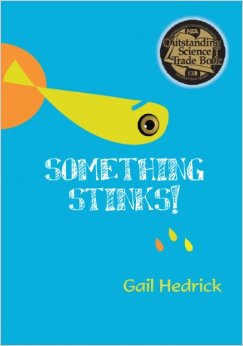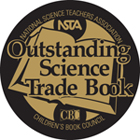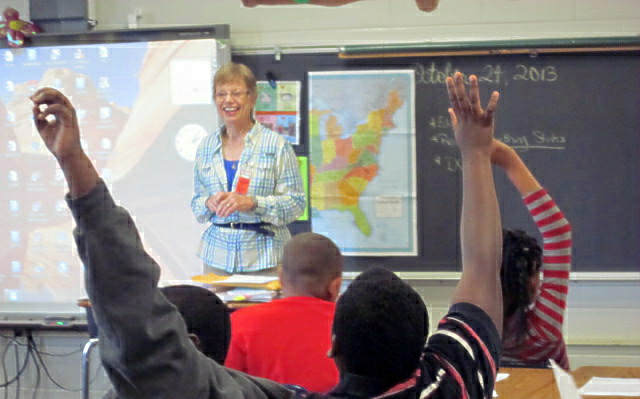Using Fiction to Excite Middle Grades Kids about Science

Who would have thought a non-scientist’s book would be selected as an outstanding science trade book? It’s true: my science-driven mystery novel Something Stinks! made the National Science Teachers Association/Children’s Book Council’s Outstanding Trade Book list for 2014.
Science mysteries are my publisher’s specialty, but that was far from my intention when I began writing the book. Because many teachers (including science teachers, I’m sure) harbor the secret desire to write fiction for young people, I was pleased when MiddleWeb invited me to share my experience and perhaps inspire some readers here to leave the harbor and set sail on the publishing sea.
It began with a true story
We had been residents of Virginia—me a lifelong water baby. I’d been a competitive swimmer, sailor, water skier, and water safety instructor; mostly on fresh water lakes and rivers from Michigan to Texas, North Carolina, then Virginia. We had moved to Florida, but my connections to the waters of Virginia remained strong.
As a children’s writer, my radar is always up for topics of interest to kids. I began to see reports through the Southeast of fish kills. We have them in Florida related to red tide, and they are studied a lot. The fish kills in Virginia were mostly in fresh water and (according to the articles I read) no one seemed terribly interested in getting to the bottom of the problem.
I had just finished a mystery for kids set in North Carolina—and thought Virginia kids might want to know why the fish were dying, so there was my start.
Searching for a publisher

There was some interest, but mostly “not quite right for us,” and other nicely worded rejections. One day I saw a posting for a relatively new publisher, Tumblehome Learning, where editors were looking for middle grade mysteries with a science component. I thought, hmm, the kids in my book have looked at pollution from several sources, including water temperature and textile dyes.
Was that science-y enough? Yes, I decided, it really might be. The manuscript was good enough to pass muster with the first reader, and finally landed on the publisher’s desk – a medical doctor who also became my editor.
More science!
Dr. Penny Noyce (a children’s writer herself) was positive about the book’s potential. But the science would need a bit of ramping up, and of course, there was a slew of fact-checking, which at first gave me pause.
However, I felt my not being a scientist might actually give the book a more realistic spin, since I could approach the science discovery process more like the kids would, which could really be fun.
So, like the main character in Something Stinks!, I was a bit afraid of not knowing all the answers, but I was willing to jump in with both feet.
Fiction meets fact
A basic concept in science is this: something has happened, and you need to take some action to find out what and why.
For something to be responsible for a massive fish kill, whether it’s pesticides from a golf course or environmental damage from a faulty logging operation, there’s a trail to be followed — and effect with a cause. Fiction allows a vehicle for kids to take action in tracking down the causes, and not having to wait for hovering adults to lay everything out for them or work up the energy to make an effort.
Fiction can imitate life, showing that bad things can happen, and yet also demonstrate that if we are committed to action, we can make a difference. It also shows, in layers of the story, that a complex problem like pollution is not likely to be solved by simply saying ‘”Oh, let’s don’t do this anymore.”
Science is more than people in lab coats peering into test tubes. Through fiction, I found it was possible to show there is an economic side to environmental science. Science involves many skills, from observation and proving a theory, to obtaining financial support, writing up research, and the exchange of ideas.
Other elements of fiction
Initially, there was no particular reason for the main character to be a girl, as I enjoy writing both boys and girls into a story. However, with the main character being a girl, I was able to encourage the idea that science is not just for boys. I’ll admit I loved weaving this concept into the story. This provided a subtle nudge for girls to enjoy and embrace science, while discovering the possibility of an interesting and sometimes exciting career.
Finally, using fiction allowed me to show that, sometimes, unfounded accusations can cause dire consequences on both sides of a controversy. Proof and the process of proving are important, and these kids in Something Stinks! had to keep at the process until the mystery of the fish kills was solved or face their own consequences.
So, that was how this work of fiction began, and how it got to a publisher. However, as I tell the kids in school author visits, when a publisher says, “We are interested,” it does not mean, poof, we have a book!
How the book developed
For me, it meant the start of the revision process. The book was revised, line by line, five times between August and December, 2012. The changes ranged from nuts and bolts- punctuation and typos, to the order of chapters and events in the story. In addition, I needed to help my characters grow, crank up the excitement, and as mentioned, help the kids use science to try to prove their accusations.
I love the revision process, and this one had the added feature of the science. I knew the kids needed to expand their knowledge of testing for water quality and the Tumblehome team, all with science backgrounds, kept following up and pointing me in the right direction. Then I would do a bit more research and weave it into the story. And, weave we did until in late December 2012, when I got the magic words in an email, ‘We have a book.”
A contract ensued, cover art was discussed and agreed upon, a font was chosen, acknowledgment and thank-you pages were written, and by the end of March, 2013, Something Stinks! was released. The book was well-received by educators and well-reviewed – and when kids have read it, very well-liked.
Would I do it again?
Most people think writing a book is hard work, but most authors find promoting to be the real challenge. Still, social media, networking, and school visits are the backbone of promotion for a children’s author. And who doesn’t like talking about themselves and about their work?

I’ve been asked, would I write another science-based novel? Well, I love mysteries and writing for kids. Science is the most wondrous of mysteries. So, my answer is yes, and the fun part is, the possibilities are endless!
Preview the first five chapters of Something Stinks at the publisher’s webpage.
Gail Hedrick is a former physical education teacher who writes on fitness and etiquette as well as middle grades mysteries. She grew upon a lake in Michigan, spent many years on rivers in Virginia and North Carolina, and now lives in Florida. Something Stinks is her first science book. Visit her author website and follow her on Twitter @GailHedrick.
































Great read for your late elementary/middle school child!